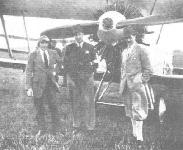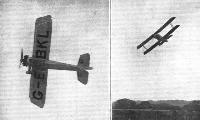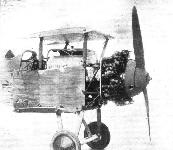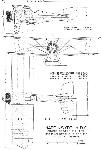
Варианты
- Martinsyde - F.3 / F.4 Buzzard - 1918 - Великобритания
- Martinsyde - F.4A / F.6 / A - 1919 - Великобритания
- Martinsyde - A.D.C.1 / Nimbus - 1924 - Великобритания
Martinsyde. Серия F
Варианты
A.D.C.1: вариант, разработанный компанией "Aircraft Disposal Company" после ликвидации "Martinsyde" в 1921 году; отличался главным образом мотором Armstrong Siddeley Jaguar мощностью 395 л.с.
Nimbus Martinsyde: один самолет, конвертированный "A.D.C." под установку мотора A.D.C. Nimbus мощностью 300 л. с.
Описание:
- Martinsyde. Серия F
- Flight, November 1924
THE MARTINSYDE A.D.C I SINGLE-SEATER FIGHTER - Flight, June 1926
ANOTHER INTERESTING A.D.C. MODIFICATION - Flight, July 1928
A.D.C. "NIMBUS-MARTINSYDE”
Фотографии
-
Flight 1926-07 / Flight
Entered by Col. M. O. Darby, the Airdisco Martinsyde "A.D.C.I," which will be piloted by Sqdn.-Ldr. W.H. Longton, is fitted with a Siddeley "Jaguar" engine of 395 h.p.
-
Flight 1924-11 / Flight
THE MARTINSYDE A.D.C.1: Front view. The engine is an Armstrong-Siddeley "Jaguar."
-
Flight 1924-12 / Flight
FOREIGN INTEREST IN THE MARTINSYDE A.D.C.1: The photograph was taken on the occasion of a demonstration of the successful and latest production of the Aircraft Disposal Co at Waddon. The group reading from left to right, includes Maj. J. Stewart (Sales Manager of the A.D.C.), Col..M. O. Darby (Managing Director), Capt. T. Toyoda (Japanese Naval Attache), Capt. Cortijo (Spanish Royal Naval Commission), Lieut.-Comdr. Kato (Imperial Japanese Navy), and Capt. Square (Spanish representative of the A.D.C.).
-
Flight 1925-08 / Flight
AN A.D.C. GROUP: Mr. Perry, Major Stewart and Capt. Walker, standing by the A.D.C.l, on which Perry and Longton gave exhibition flights.
-
Flight 1925-08 / Flight
INTERESTING VISITORS AT WADDON: On July 20 distinguished visitors from foreign parts inspected the Martinsyde-Jaguar ADC.l machine at the Aircraft Disposal Company's works at Waddon. The group shown above, standing in front of the ADC.I are, from left to right: Maj. J. Stewart (A.D.C., Ltd., Sales Manager); Maj. Sarmento de Beires of the Portuguese Military Aviation Service, Who flew from Lisbon to Macao last year; Comdr. R. Fitz-Simon, of the Argentine Naval Air Service; and Capt. Walker (A.D.C., Ltd., Works Manager).
-
Flight 1925-07 / Flight
Регистрационный номер: G-EBKL [4] THE KING'S CUP: Some of the first day's starters. W.H. Longton's A.D.C. Martinsyde hurrying to the line.
-
Aeroplane Monthly 1978-02 / Personal album
Регистрационный номер: G-EBKL [4] The Jaguar-engined Martinsyde A.D.C.1 G-EBKL was an updated F.4, and first flew on October 11, 1924. It competed in the 1925 and 1926 King's Cup Air Races, and was finally burnt at Croydon in 1936 after withdrawal from the register in April 1927.
-
Flight 1925-08 / Flight
Регистрационный номер: G-EBKL [4] SOME OF THE LARGER MACHINES AT LYMPNE: From left to right, the Avro-Lynx, Bristol "Lucifer," Bristol "Bloodhound," S.E.5, Sopwith "Gnu," A.D.C.I, and a sky-writing S.E.5.
Другие самолёты на фотографии: Avro Avro 504N - Великобритания - 1920Bristol Bloodhound / Type 84 - Великобритания - 1923Bristol Taxiplane / Primary Trainer - Великобритания - 1923RAF S.E.5 - Великобритания - 1916Sopwith Gnu - Великобритания - 1919
-
Flight 1926-07 / Flight
Регистрационный номер: G-EBKL [4] THIRD IN THE KING'S CUP RACE: Two views of the Martinsyde A.D.C.1 (Siddeley "Jaguar") completing two of his early laps.
-
Flight 1925-08 / Flight
ENTERTAINER: Perry on the Martinsyde A.D.C.I.
-
Air International 1985-12 / Fighter A to Z
Two of the A.D.C.1 derivatives of the Buzzard supplied to Latvia in 1926
-
Авиация и Космонавтика 2018-04 / С.Дроздов - В небе Латвии (1918-2018)
Опознавательный знак латвийских самолетов в виде свастики красного цвета на белом фоне не имел никакого отношения к фашистской символике, так как появился задолго до прихода к власти в Германии нацистов во главе с Адольфом Гитлером
-
Flight 1924-11 / Flight
The Martinsyde A.D.C.1: View of engine mounting, etc. This photograph was taken before covering.
-
Flight 1926-06 / Flight
A BROADSIDE: Mr. H. H. Perry flying the A.D.C. "Nimbus-Martinsyde" at Croydon aerodrome. The neat engine cowling is well illustrated in this view.
-
Flight 1926-06 / Flight
THE A.D.C. "Nimbus-Martinsyde": These three views of the machine flying, piloted by Mr. H. H. Perry, serve to show the clean lines, especially the front view, the taking of which required considerable nerve on the part of the photographer, as the machine was approaching him "all-out." Mr. Perry "zoomed" about one second after this picture was taken.
-
Flight 1926-06 / Flight
A POSSIBLE "KING'S CUPPER": A.D.C. Aircraft, Ltd., have just produced this version of the Martinsyde F.4, fitted with the "Nimbus" engine designed by Major Halford. The conversion has been designed by Mr. John Kenworthy, who has managed to turn out an extremely "clean" machine, which should be useful for advanced training.
-
Flight 1928-07 / Flight
Регистрационный номер: G-EBOJ [7] -
Air International 1985-12 / Fighter A to Z
Регистрационный номер: G-EBOJ [7] The A.D.C. Nimbus version of the Buzzard which progressed no further than the prototype stage.
-
Flight 1926-07 / Flight
Регистрационный номер: G-EBOJ [7], G-EBOL "THE HEAVENLY TWINS": The two Nimbus Martinsydes, piloted by Capt. F. T. Courtney (G-EBOL) and H. H. Perry (G-EBOJ) start off together on the first lap of the King's Cup Race at Hendon on Friday.
-
Flight 1926-09 / Flight
Регистрационный номер: G-EBOJ [7] THE LANCASHIRE AIR PAGEANT: Captain Courtney on the A.D.C. Nimbus-Martinsyde starts scratch in the Open Handicap.
-
Flight 1927-08 / Flight
Регистрационный номер: G-EBOJ [7] THE NOTTINGHAM FLYING MEETING: The winner of the High Power Handicap - Sqdn.-Leader Hubert Jones on the "Boreas-Nimbus-Martinsyde."
-
Flight 1928-05 / Flight
Регистрационный номер: G-EBOJ [7] REPRESENTATIVE TYPES OF BRITISH AIRCRAFT: 4. The A.D.C. "Nimbus-Martinsyde" single-seater fighter.
-
Flight 1926-07 / Flight
Регистрационный номер: G-EBOJ [7] "AND THEN THERE WAS NONE": Much disappointment was felt generally at the bad luck experienced by the two Nimbus Martinsydes in the King's Cup Race. Above is seen H. H. Perry banking on one of these 'buses, and inset, Col. Bristow gives him correct B.S.T.
-
Flight 1928-05 / Flight
AT HAMBLE: In the picture are the machines lined up for the important Morris Open Handicap, and the nearest machine is Cant. Stack's Martinsyde-Nimbus, which won it at a speed of 129 3/4 m.p.h.
-
Flight 1924-11 / Flight
The Martinsyde A.D.C.1: View from above showing cockpit, guns, etc.
-
Flight 1924-11 / Flight
The machine-guns on the Martinsyde A.D.C.1 are very accessible. This sketch shows how the two sliding doors on the deck fairing allow of getting at the gun mechanism. The port chute for the empty cartridges can also be seen.
-
Flight 1924-11 / Flight
The simple gravity petrol system of the Martinsyde A.D.C.1. The upper pipe is for priming, and conducts petrol to the induction system of the engine.
-
Flight 1924-11 / Flight
Perspective sketch of the tubular engine mounting of the MartinSyde A.D.C.1: The "Jaguar" engine can be removed from the machine by undoing the four corner bolts.
-
Flight 1924-11 / Flight
Martinsyde A.D.C.1 Single Seater Fighter 380 hp. Armstrong Siddeley "Jaguar" Engine
- Фотографии




























